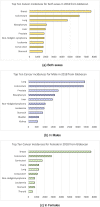Burden of cancers attributable to modifiable risk factors in Malaysia
- PMID: 33637056
- PMCID: PMC7908668
- DOI: 10.1186/s12889-021-10412-9
Burden of cancers attributable to modifiable risk factors in Malaysia
Abstract
Background: This is a systematic assessment of the burden of cancers in Malaysia in 2018 using epidemiologic approach. The purpose of this study was to identify the proportion of cancers in Malaysia that were attributable to the modifiable risk factors of excess weight, alcohol intake, physical inactivity, tobacco smoking and to estimate the number of cancer cases that could be prevented if the exposure to the modifiable risk factor was reduced.
Methods: We estimated the Population Attributable Fraction (PAF) of the modifiable risk factors to cancers incidences in Malaysia. The two parameters used for the estimation were exposure prevalence from national representative surveys and the relative risk of getting the cancers from worldwide literature review.
Results: Among 38,426 cancer incidences in 2018 from Globocan data, we estimated that 22.2% (95% confidence interval (CI):14.9 to 29.6%) of the cancer incidences included in this study were attributable to the investigated modifiable risk factors. 39.1% (95% CI:27.2 to 49.7%) and 10.5% (95% CI:5.8 to 15.7%) of cancers in male and female respectively, were attributable to the studied modifiable risk factors. The top main cancers attributed by the risk factors were lung cancer (65.1%; 95% CI:56.4 to 72.9%), laryngeal cancer (63.6%; 95% CI:39.9 to 80.5%), and oesophageal cancer (51.5%; 95% CI:39.9 to 62.0%). For each risk factor studied across genders, tobacco smoking contributed the most (14.3%; 95% CI:9.9 to 17.3%), followed by excess weight (7.0%; 95% CI:4.1 to 10.2%), physical inactivity (1.0%; 95% CI:0.4 to 1.7%) and alcohol intake (0.6%; 95% CI:0.2 to 1.0%).
Conclusion: Findings from this study suggests that tobacco smoking and excess weight are the two predominant factors out of the four studied risk factors for cancer cases in Malaysia. Nationwide public health prevention campaigns tailored to these risk factors are recommended. However, the other risk factors such as physical inactivity and alcohol intake shall not be neglected. PAFs are estimated based on the best available data that we have currently. Regular collection of other risk factor exposure prevalence data is vital for future analyses.
Keywords: Alcohol intake; Burden; Cancer; Excess weight; Malaysia; Modifiable risk factor; Physical inactivity; Population attributable fraction; Tobacco smoking.
Conflict of interest statement
The authors declare that they have no conflicts of interests. We have obtained permission from the Director General of Health Malaysia to publish this article.
Figures



Similar articles
-
Immediately modifiable risk factors attributable to colorectal cancer in Malaysia.BMC Public Health. 2017 Aug 4;17(1):637. doi: 10.1186/s12889-017-4650-8. BMC Public Health. 2017. PMID: 28778191 Free PMC article.
-
The fraction of cancer attributable to modifiable risk factors in England, Wales, Scotland, Northern Ireland, and the United Kingdom in 2015.Br J Cancer. 2018 Apr;118(8):1130-1141. doi: 10.1038/s41416-018-0029-6. Epub 2018 Mar 23. Br J Cancer. 2018. PMID: 29567982 Free PMC article.
-
Preventability of Colorectal Cancer in Saudi Arabia: Fraction of Cases Attributable to Modifiable Risk Factors in 2015-2040.Int J Environ Res Public Health. 2020 Jan 2;17(1):320. doi: 10.3390/ijerph17010320. Int J Environ Res Public Health. 2020. PMID: 31906520 Free PMC article.
-
The fractions of cancer attributable to modifiable factors: A global review.Cancer Epidemiol. 2016 Oct;44:203-221. doi: 10.1016/j.canep.2016.06.013. Epub 2016 Jul 25. Cancer Epidemiol. 2016. PMID: 27460784 Review.
-
Obesity as an Avoidable Cause of Cancer (Attributable Risks).Recent Results Cancer Res. 2016;208:243-256. doi: 10.1007/978-3-319-42542-9_13. Recent Results Cancer Res. 2016. PMID: 27909911 Review.
Cited by
-
Fighting Cancer around the World: A Framework for Action.Healthcare (Basel). 2022 Oct 25;10(11):2125. doi: 10.3390/healthcare10112125. Healthcare (Basel). 2022. PMID: 36360466 Free PMC article.
-
Prediction of Productivity Costs Related to Cervical Cancer Mortality in Indonesia 2018.Malays J Med Sci. 2022 Feb;29(1):138-144. doi: 10.21315/mjms2022.29.1.13. Epub 2022 Feb 23. Malays J Med Sci. 2022. PMID: 35283686 Free PMC article.
-
Health status based on EQ-5D-5L for the cancer patient population in Malaysia.Sci Rep. 2024 Apr 8;14(1):8152. doi: 10.1038/s41598-024-58844-8. Sci Rep. 2024. PMID: 38589488 Free PMC article.
-
Proportion of cancer cases and deaths attributable to potentially modifiable risk factors in Peru.BMC Cancer. 2024 Apr 15;24(1):477. doi: 10.1186/s12885-024-12219-4. BMC Cancer. 2024. PMID: 38622563 Free PMC article.
-
Challenges and Strategies for Improving Access to Cancer Drugs in Malaysia: Summary of Opinions Expressed at the 2nd MACR International Scientific Conference 2022.Cancer Manag Res. 2023 Aug 21;15:851-862. doi: 10.2147/CMAR.S420890. eCollection 2023. Cancer Manag Res. 2023. PMID: 37636030 Free PMC article.
References
-
- (WHO) WHO. Cancer Fact Sheets [Internet]. 2018 [cited 2020 May 4]. Available from: https://www.who.int/news-room/fact-sheets/detail/cancer
-
- World Health Organization (WHO). Western Pacific Regional Action Plan For Noncommunicable Diseases. 2009.
-
- Levin ML. The occurrence of lung cancer in man. Acta Unio Int Contra Cancrum. 1953;9:531–541. - PubMed
-
- Whiteman DC, Wilson LF. The fractions of cancer attributable to modifiable factors: a global review. Cancer Epidemiol 2016;44:203–221. Available from: http://dx.doi.org/10.1016/j.canep.2016.06.013 - PubMed
MeSH terms
LinkOut - more resources
Full Text Sources
Other Literature Sources

